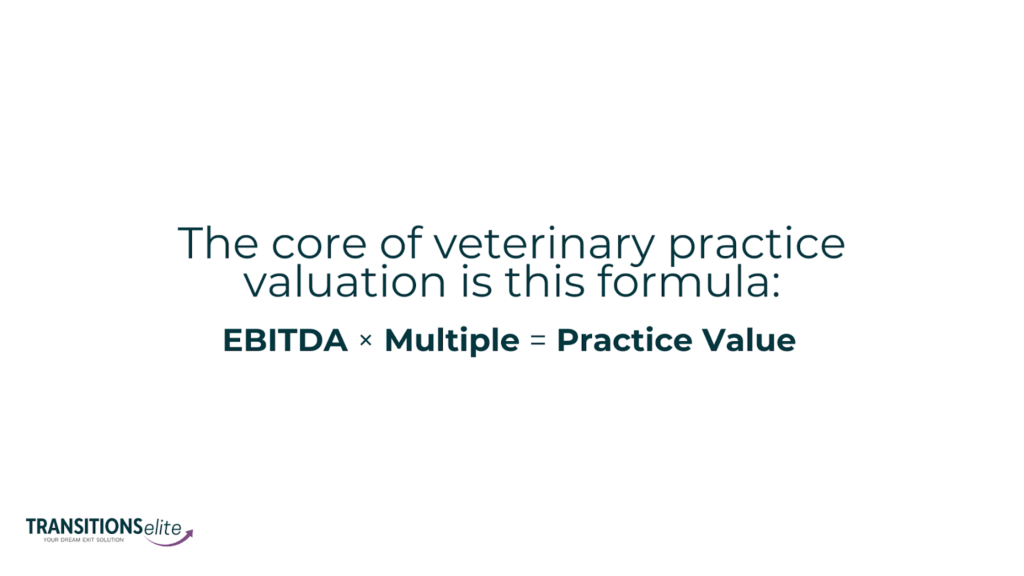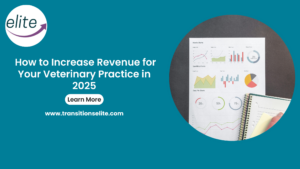How Valuations Work for Vet Practices and What Owners Should Know
A good veterinarian does not jump to conclusions. They gather data, observe patterns, ask the right questions, perform the appropriate tests, and then make what we can safely refer to as objective determinations or data-based assumptions, one or the other. Figuring out the value of a veterinary practice works in much the same way.
If you’re thinking about selling your veterinary practice, there’s one crucial number you need in hand before making any decisions: your practice’s true market value. What goes into determining that figure might surprise you.
So, let’s unpack what valuation means in veterinary medicine and explore all the factors that help us reach the most accurate figure possible.
What “Valuation” Really Means in Veterinary Medicine
If you’ve been asking yourself, “How much is my veterinary practice worth?”, it’s a good idea to learn how actually to calculate it.
When we speak of valuation, people automatically assume there will be a singular, final number, like the cost of a vehicle or piece of clothing. Business valuation is quite different from that of a product, as things are even more complex for something like a veterinary practice.
Here, the process of value determination hinges on measurable data points, including, but not limited to:
- Financial performance
- Potential for growth
- Operational efficiency without the owner’s presence
- Market timing
Similar to diagnosing, the process involves gathering the right information, analyzing patterns, asking the right questions, and applying proven methods to reach a well-supported conclusion. Valuation isn’t merely about what you’ve built, but also what a buyer believes it’s worth (based on the factors stated above), and how they can continue running it profitably and grow once ownership has been transferred.
That’s why two clinics with the same revenue can have very different valuations. One might be well-oiled and scalable, while the other might be too reliant on one person holding everything together.
In the end, valuation is determined by current and future potential. Predictions are made, backed by numbers, of how valuable your practice will be to its next owner.
Why Getting an Accurate Number Matters
If you’re merely curious about your vet practice’s value, sure, an estimate should do. However, if you’re serious about selling your practice, an accurate number is important because it provides clarity, helps you develop a strategy, and determines your leverage.
No matter if you’re planning to sell right now or a couple of months later, an accurate valuation only empowers you. Even a slight deviation from the correct price can result in a bad deal. Price it too low, and you could be leaving serious money on the table. Price it too high, and you risk scaring off qualified buyers or sitting on the market for months with no real offers. Neither outcome is ideal.
A data-based, well-supported valuation can help guide several important decisions, such as:
- Making informed decisions about when and how to exit
- Identifying areas to improve that can significantly raise your sale price
- Planning for retirement
- Avoiding underpricing or overpricing
- Strengthening your negotiating position with a data-backed valuation, especially in deals involving private equity or corporate buyers
- Securing loans for expansion or renovation
- Understanding your net worth
Without an accurate number, practice owners are left in the dark, guessing, relying on rules of thumb that do not reflect real market conditions, and hearsay.
The Best Time to Value Your Practice
Most clinic owners wait until they’re ready to sell before they think about getting a proper valuation. By then, it is rather late to make any meaningful changes that could improve their position.
The best time to value your practice is well before you’re ready to sell. This way, you get plenty of time to think about how you can address shortcomings that may lower your practice’s price, improve profitability, hire or restructure your team to lower owner dependency, and wait for favorable market conditions to make the sale.
It is best to value your practice early on so you’re able to track how the changes you implement affect its value over time. Say, if you’re thinking about selling in the next couple of years, ranging from one to three years. It is ideal, as buyers don’t make a decision based on a couple of good months but a solid history of profit, growth, and stability. Having that puts you in a better position.
If you’re not planning to sell anytime soon, it is still worth knowing your practice’s value. It can help in things like loan applications, retirement planning, or just understanding your net worth.
Core Formula: EBITDA × Multiple

First things first, what is EBITDA? It stands for Earnings Before Interest, Taxes, Depreciation, and Amortization, and it is, in the simplest of words, your practice’s true profit before additional costs like debt and taxes. It is what your business really makes from its core operations.
A practice is only worth what someone is willing to pay for it, and buyers do not do business without looking at EBITDA, as it provides a real and clear picture of the profits your practice makes.
It showcases how financially sound your practice is. The higher and more stable your EBITDA, the more valuable your practice becomes.
Now, what’s the “multiple”?
This is where things start to get a little complex. The multiple is a number (often between 4x and 12x, depending on the buyer and market) that reflects how valuable your EBITDA is to a potential buyer. So, if your EBITDA is $200,000 and your practice earns a 6x multiple, your valuation would be approximately $1.2 million.
A wide range of factors determines that multiple factors, including but not limited to:
- Size of your EBITDA (larger practices often get higher multiples)
- Location and demographics
- Growth potential
- Stability of revenue
- Level of owner involvement (less dependence on you = higher value)
- Team strength and staffing
- Market conditions (e.g., high demand or competition from buyers)
- Type of buyer (private equity often pays higher multiples than individual vets)
Remember what we stated about two clinics having the same revenue but different valuations? Well, here too, two clinics with the same EBITDA might sell for vastly different prices based on how strong or risky they appear to buyers.
To put it in a nutshell: your multiple showcases the appeal of your business, whereas EBITDA shows its financial performance. A practice that is running strong and has the potential to scale will always command a higher multiple because it carries lower risk and offers higher return potential.
Factors That Can Push Your Multiple Up (or Down)
The multiple is a reflection of how attractive your practice is to a buyer. The multiple is where your valuation can gain or lose serious ground. Your multiple can rise or fall depending on a variety of operational, financial, and market-related factors. And sure, while it is difficult to control everything, many of the factors that influence the multiple are well within your control.
Here are the key factors that can push your multiple up:
- Strong and Consistent EBITDA: Consistency matters as buyers want to invest in a reliable business.
- Low Owner Dependency: If a clinic runs just fine without you, it’s easier to transition into for the buyer.
- Established Structure: If your practice has a solid team with leadership roles predefined with low staff turnover, it is a major green flag.
- Location and Demographic: A practice located in an urban setting, where people have more pets and disposable income, means there will be more opportunities for growth. Location determines competition, too.
- Positive Growth Trends: Year-over-year increases in revenue and client numbers showcase growth in the right direction.
- Private Equity Interest: Private Equity buyers often pay more for scalable and well-positioned practices.
On the flip side, here’s what can lower your multiple:
- Over-reliance on the Owner: If the practice depends heavily on your presence, it’s riskier for buyers and thus becomes a red flag.
- Staffing Shortages or Instability: If you’re understaffed, in terms of quality or quantity, it’s yet another red flag.
- Inconsistent Financials: Buyers look for operational consistency, not volatility. They want a practice with stable finances.
- Lack of Growth or Flat Performance: A stagnant business is less appealing to investors as there are no or limited growth opportunities there.
- Outdated Systems or Poor Workflows: Operational inefficiencies reduce value and increase transition effort. Buyers (not all) aren’t always interested in meddling in medical practice and want a practice that runs efficiently.
- High Local Competition: If there are many similar practices nearby, it can reduce buyer interest.
Understanding these levers gives you the power to make changes today that could significantly increase your valuation.
Simple Tweaks to Boost Your Clinic’s Worth Before You Sell
Before you go out to sell your practice, it’s best to get everything in order to get the best possible offer. You don’t need to reinvent your entire practice to make it more valuable. In fact, small changes and improvements can have a massive impact on the buyer’s perception of your clinic and influence how much they’re willing to pay for it. Here are some things you can start with:
- Clean Up Your Financials
Buyers want, respect, and value transparency. Handing them a business with messy bookkeeping is unprofessional, and let’s not forget that they will probably want to look at your finances beforehand. So, make sure your books are up to date, personal expenses are separate, and your profit and loss statements are clearly stated and easy to understand. A well-organized financial history builds trust and confidence.
- Reduce Owner Dependency
Naturally, if a clinic is dependent on you, the owner, for daily functionality, it isn’t going to be very appealing to a buyer. After all, there will be a transfer of ownership and, based on the agreed-upon terms, you may or may not play an active role in the functioning of the clinic.
So, it is best to start shifting day-to-day responsibilities to your team. Delegate clinical tasks to the appropriate individuals, train staff to handle operations, and build systems that do not rely on you being available, ideally at all. You need to show buyers that the business can run fine without you at the center of it all.
- Raise Your Prices Strategically
If you haven’t reviewed your pricing in a while, now is the time. It doesn’t have to be drastic. Small adjustments to your fee schedule can do the trick. They will increase your revenue and, therefore, EBITDA, which in turn will increase your valuation, all without acquiring any new clients. However, you should focus on that as well.
- Address Staffing Gaps
A practice with a stable, capable team is worth more. Fill key roles, cross-train your staff, and reduce turnover wherever possible. A well-functioning team tells buyers your clinic is low-risk and sustainable.
- Optimize Your Scheduling
Are you fully booked throughout the week? That’s good. If not, consider tightening up your scheduling process, reducing no-shows, and offering online booking to increase perceived demand. This shows both current and future potential, increasing your valuation.
- Refresh the Clinic’s Appearance
Aesthetics matter, and it is undeniable. So, work on it. You don’t need to renovate the entire place. Just do the basics: tidy up the space, replace worn-out furniture, and perhaps apply a fresh coat of paint.
- Strengthen Your Client Base
Buyers look for loyalty, stability, and an ongoing stream of revenue, along with potential revenue. Things like high retention rates (staff and clients), an active email list, and positive reviews are all green flags.
These changes may seem small on their own, but collectively, they make your clinic look much stronger, more profitable, and easier to transition into. The sooner they are implemented, the better your chances of getting a higher valuation.
Step-By-Step Veterinary Practice Valuation Checklist
Before obtaining a valuation for your veterinary practice, it’s a good idea to tick each box of this checklist:
- Pull together your profit and loss statements, balance sheets, and tax returns from the last three years. These are essential for showing how your clinic is performing over time.
- Remove any one-off expenses or personal costs that ran through the business. These can skew the numbers and make your practice look less profitable than it really is.
- Take a look at how your team is set up. Are you staffed efficiently? What’s your vet-to-support-staff ratio like? Also, check if turnover is high or if your pay structure is competitive.
- Analyze your location and real estate status (owned vs. leased, transferable lease terms, property value).
- Assess growth trends, doctor productivity, and operational sustainability (e.g., whether the practice depends on a single high-producing veterinarian).
- Factor in specialty services or niche offerings, such as feline-only care or advanced surgical capabilities.
- Think about what could scare off a buyer, like if everything depends on just one vet (maybe you), or if there aren’t any associates in place to keep things running smoothly.
- See what similar clinics in your area have sold for, and check how your numbers stack up. Most practices are valued using a multiple of adjusted EBITDA, so that gives you a solid ballpark.
- In order to guide you through the process, it is best to work with a practice sales advisor.
- Prepare all the necessary documents for the buyer, including but not limited to HR policies, equipment inventory, lease agreements, client metrics, and employee contracts.
How Transitions Elite Helps Owners Max Out Value

You’ve built something meaningful. Something that deserves more than a quick sale or lowball offer. You deserve top dollar and peace of mind knowing your legacy stays protected. That’s where Transitions Elite comes in.
We help veterinarians sell their practice for maximum value, on your terms, not anyone else’s. Here’s how we make it happen:
- We assist in determining the actual, real-time market value of your clinic based upon real industry-accepted parameters, not rules of thumb.
- We work with our sister company, DVM Elite, to grow revenue, profitability, and practice performance before sale. Your metaphorical practice for sale sign goes up when the market timing is perfect.
- Instead of doing it the way brokers do, create a listing and wait, we create a bidding environment that drives terms and prices in your favor.
- We make sure you retain medical control while operational tasks like HR, payroll, and taxes are handled by the buyer (only, of course, if you want to go down that route).
- Taking care of the paperwork, making sure you’re educated about the entire process, and maintaining complete transparency throughout.
- We don’t just stop at the sale. We help you plan a smooth handover that keeps your clinic running strong and reassures buyers that they’re stepping into a stable operation.
Transitions Elite specializes in dealing with veterinary practices, and it is at full display when we look at the results we’ve been able to achieve.
Since the process of selling a veterinary practice can take anywhere from a couple of months to years, it is one of the biggest financial decisions ever for a veterinarian, so make it wisely. Get a free evaluation of your practice today.
Closing Thoughts
When we talk about selling a veterinary practice, we need more concrete numbers, and we need to know its potential. By understanding your EBITDA, knowing your multiple, and making smart tweaks ahead of time, you can get a real idea of where your practice stands in the market and maximize your outcome when it’s time to sell.
FAQs
How do you calculate the value of a veterinary practice?
The value of a veterinary practice is based upon a multiple of adjusted EBITDA, which stands for Earnings Before Interest, Taxes, Depreciation, and Amortization. These adjustments may include normalizing the owner’s salary and removing non-operational expenses. The multiple depends upon factors like location, revenue trends, staffing, and buyer interest, often ranging from 4× to 12× EBITDA.
What is a good EBITDA for a veterinary practice?
A “good” EBITDA is hard to determine, as it isn’t a stand-alone number but one that depends upon several factors. Generally, for smaller practices, it is $100K–$300K, for mid-sized practices, it’s $300K–$750K, and large-scale practices can go beyond that. The higher the EBITDA and the stability of earnings, the more attractive your practice is to buyers.
How profitable is a veterinary practice?
It depends from one practice to another, really. However, a well-functioning practice sees a 10%–20% net profit margin.
How do I sell my vet practice?
In order to sell your vet practice, one must start by preparing clean financials and adjusting for add-backs, hiring a veterinary-specific broker or advisor like Transitions Elite, increasing EBITDA through growth strategies and staffing improvements, creating a buyer-ready document package (leases, HR, metrics), and finally marketing to both corporate and private equity-backed buyers. The entire process can take anywhere from 6 months to a year or more, so plan accordingly.

Melani Seymour, co-founder of Transitions Elite, helps veterinary practice owners take action now to maximize value and secure their future.
With over 15 years of experience guiding thousands of owners, she knows exactly what it takes to achieve the best outcome.
Ready to see what your practice is worth?











